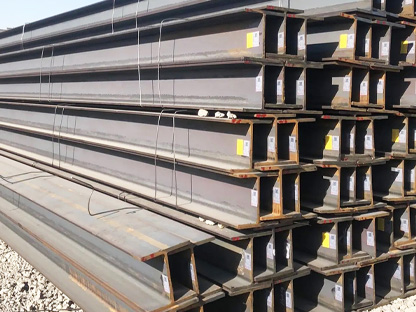
Name: Industry News
Ⅰ. Detailed interpretation of H-beam inspection standards and specifications
1. Dimension and tolerance inspection
The cross-sectional dimensions of H-beam directly affect the structural bearing capacity. According to the requirements of GB/T 11263-2023, the inspection items include height (H), flange width (B), web thickness (t₁), flange thickness (t₂) and cross-sectional asymmetry. Taking height deviation as an example, the standard stipulates that the allowable deviation is ±2.0mm (H≤400mm) or ±3.0mm (H>400mm). ISO 657-19:2023 requires that the flange width deviation shall not exceed ±1.5% (B≤200mm) or ±1.0% (B>200mm).
2. Mechanical properties inspection
The mechanical properties of H-beam must meet the requirements of tensile strength, yield strength, elongation and impact energy. GB/T 11263-2023 stipulates that the yield strength of Q355B grade steel is ≥355MPa and the tensile strength is 470-630MPa. ASTM A6/A6M-24 requires the Charpy V-notch impact energy (-20℃) to be ≥27J. During the test, the sample must be cut according to the standard to avoid interference from the heat-affected zone.
3. Chemical composition analysis
The carbon equivalent (Ceq) of H-beam directly affects the welding performance. GB/T 11263-2023 requires Ceq≤0.44% (plate thickness≤20mm). ASTM A6/A6M-24 stipulates that phosphorus (P) ≤0.025% and sulfur (S) ≤0.015%. The detection uses a spectrometer, and the sampling position needs to avoid the 150mm area at the end.
4. Surface quality and defect detection
Surface defects such as cracks, folds, and scars will reduce fatigue life. GB/T 11263-2023 stipulates that the depth of surface defects shall not exceed 5% of the nominal thickness and must be smoothed. ASTM A6/A6M-24 requires visual inspection without visible delamination. Detection must be combined with magnetic particle testing (MT) or penetrant testing (PT).
5. Residual stress detection
Improper welding or rolling process will cause residual stress to exceed the standard. ISO 657-19:2023 recommends using X-ray diffraction or blind hole method for measurement, and the residual stress value shall not exceed 30% of the material yield strength.
6. Welding performance test
For H-beams to be welded, an inclined Y-groove test (GB/T 4675.1-2016) is required to evaluate cold crack sensitivity. ASTM A6/A6M-24 requires a carbon equivalent (Ceq) of ≤0.45% to ensure weldability.
II. Overview of the Standard System
The Vietnamese market mainly uses international standards such as ISO 6935, ASTM A36/A572, and combines the Vietnamese local specification TCVN 6524:2019 for import inspection of H-beams. As an internationally recognized third-party testing organization, SGS's certification includes the following core items:
Mechanical performance testing
Yield strength (≥345MPa)
Tensile strength (490-620MPa)
Elongation (≥21%)
Impact toughness (≥27J at -20℃)
Chemical composition analysis
Element content requirements (%)C≤0.20Si0.15-0.40Mn1.00-1.60P≤0.025S≤0.020
III. Key testing process
Dimension tolerance testing
Web thickness deviation ±0.3mm
Flange width deviation ±1.5mm
Length tolerance +50/-0mm
Surface quality requirements
Crack depth ≤0.1mm
Rust area ≤3%
Delamination defects are not allowed
Special project testing
RoHS testing required by Vietnam Customs (6 items including lead and cadmium)
Fire performance test (ASTM E119)
IV. Certification considerations
A complete material traceability document (MTC) must be provided
The packaging must comply with Vietnam's GSO 20:2019 moisture-proof standard
The sampling rate for each batch shall not be less than 5%
The certificate is valid for 12 months
(Attachment) Common unqualified item treatment solutions:
Excessive chemical composition: It is recommended to add vanadium/niobium microalloying treatment
Dimensional deviation: Adjust the mill roll gap compensation value
Surface defects: Use grinding wheel grinding process